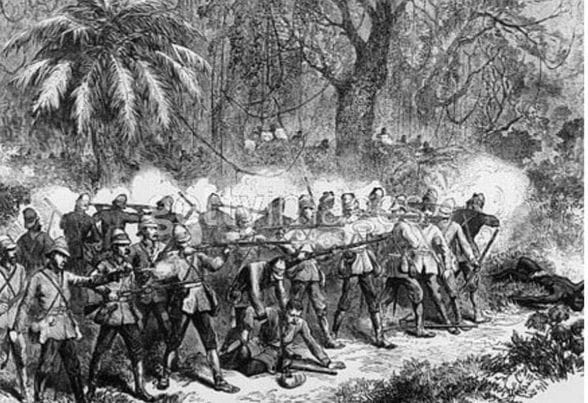In the early 19th century, the Ashanti Empire, a prominent Akan kingdom in West Africa, found itself at odds with the expanding British Empire. On 21st January 1824, this friction culminated in the Battle of Nsamankow, in which the Ashanti scored a glorious victory against the British.
The British force was led by Sir Charles MacCarthy, the governor of the British territories on the Gold Coast (in present-day Ghana) of West Africa. It comprised British troops and their African allies, including the Fantis, another Akan people group.
Interestingly, the Battle of Nsamankow did not derive its name from its location. Instead, it was called so because when the Ashantis were shooting from a thick bush, the Fantis could not see them and therefore thought they were fighting with ghosts, which translates in Akan as ‘Saman’. The battle was part of the First Anglo-Ashanti War which took place from 1823-1831.
In this article, we will explore the events that led to the battle as well as its outcome.
Background
From the 18th century, the economy of the Ashanti Empire, also known as the Asante Empire, thrived and was sustained by trade in gold and slaves. The Ashanti would sell slaves to Mende and Hausa traders through the Trans-Saharan Trade Route and later, to a much larger market through the Trans-Atlantic Trade Route.
In 1807, the British abolished the slave trade, thereby depleting the global demand for slaves and essentially crippling the Ashanti Empire’s economy. This undoubtedly fuelled tensions between the British and the Ashantis.
By late 1823, the Ashanti Empire began to have conflicts with the neighbouring Fante Confederacy and the British Empire. Different sources cite various reasons for these conflicts.
According to one source, it was because the Ashanti opposed British efforts to end the slave trade and wanted a larger share of the region’s blooming commerce. Meanwhile, the Fanti people were more peaceable and aligned with the British.
According to another source, it was because the Ashantis wanted to have direct trade with the British and other European merchants. However, the Fantis stood in the way as the Ashantis had to pay tolls to the Fantis on the way. Consequently, the Ashantis sought to eliminate them and subjected them to frequent attacks. This posed a great threat to the British’s trade in the area.
Whatever the case, it can generally be deduced that the major reason the British stepped in was to protect their allies, the Fantis, and their own interests in turn. The British declared war on Osei Bonsu, the Asantehene (King of the Asante).
Ghost War
On 8th January 1824, the newly installed Governor MacCarthy, got word that the Ashanti were advancing. He then set out with an expedition of about 80 men from the Royal African Corps, 170 men from the Cape Coast Militia, and 240 Fanti tribesmen under their local chiefs.
MacCarthy was accompanied by a captain, an ensign and a surgeon of the 2nd West India Regiment, and his colonial secretary, J.T. Williams. MacCarthy also engaged over 9,000 troops from three other neighbouring groups. The plan was for his group and the three others to unite and annihilate the enemy.
On the night of the 20th, MacCarthy’s lone group of some 500 men camped by a tributary of the Pra River, which served as the border between the Ashanti Empire and the Gold Coast. The following day, at around 2PM, the British camp heard the 10,000 strong Ashanti army approaching. MacCarthy underestimated the solidarity of the Ashanti army.
He believed that many of the troops were part of smaller groups whose chiefs could easily deflect. Thus, he instructed his band to play God Save the King, the British national anthem, loudly. The Ashanti responded by inching closer and loudly beating their war drums. At this point, MacCarthy realised it was time for battle.
The two camps were separated by an 18-metre-wide stream which the Ashanti attempted to cross by cutting down trees and using them as bridges. The British fired at the Ashanti troops who tried to cross the makeshift bridges.
Yet, the small British force was no match for the 10,000-strong Ashanti army. Worse still, their weaponry supplies were limited. The bearers who were supposed to bring more gunpowder and ammunition supplies mostly fled after hearing the firing in the distance and encountering a few troops who had deserted the scene. Only four cases of supplies arrived and three of them were stuffed with macaroni. Enraged, MacCarthy threatened to hang Brandon, the ordinance keeper who had made the sorely grave mistake.
By 4PM, the British had run out of ammunition as the Ashanti advanced across the driver. Most of the Fanti troops fled and the few British who remained were overwhelmed in hand-to-hand combat.
MacCarthy, his ensign and Williams tried to fall back, but MacCarthy was wounded by gunfire. Refusing to be subjected to torture as a prisoner of war, MacCarthy killed himself at the battleground. The ensign died while trying to defend MacCarthy’s body, and Willliams was taken prisoner. The Ashanti troops cut off the heads of MacCarthy and his ensign and kept them as trophies of war.
Williams was released after a few months, only because he was recognised by an Ashanti chief for whom he had done a small favour in the past. The Ashanti later fashioned MacCarthy’s skull into a gold-rimmed drinking cup for the Asantehene. Other ‘trophy skulls’ were also used as drinking cups by Ashanti rulers.
MacCarthy’s skull was recovered from the Ashanti Empire in 1829 and interred at St Saviour’s Church in England. However, it wasn’t until 1874 that the British were able to recover the silver utensils looted from MacCarthy’s baggage.
Aftermath
Some weeks after the battle, the British returned with a larger force of White and native African troops to fight the same Ashanti army. This time, both camps reached a stalemate. On the British side, there were 176 fatalities and 677 casualties. After the battle, the British army withdrew from the Ashanti Empire for a while. In 1831, a peaceful agreement between the two empires closed the door to conflict for the next 30 years.
However, even fiercer wars were to follow, ultimately leading to the fall of the Ashanti Empire. The Second Anglo-Ashanti War took place from 1863-1864, followed by the Third Anglo-Ashanti War (1873-74), the Fourth Anglo-Ashanti War (1895-96) and the War for the Golden Stool (1900).
By January 1902, the Ashanti Empire had been declared a British crown colony. Still, the strength of the Ashantis and years of resilience made the conquest of the formidable empire especially difficult for the British.

Oyindamola Depo Oyedokun
Oyindamola Depo Oyedokun is an avid reader and lover of knowledge, of most kinds. When she's not reading random stuff on the internet, you'll find her putting pen to paper, or finger to keyboard.
follow me :
Leave a Comment
Sign in or become a Africa Rebirth. Unearthing Africa’s Past. Empowering Its Future member to join the conversation.
Just enter your email below to get a log in link.

